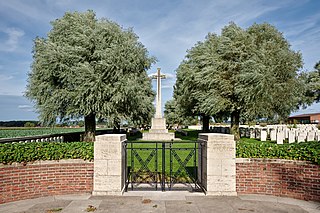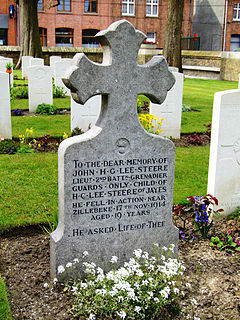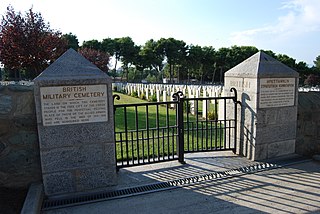The Commonwealth War Graves Commission (CWGC) is an intergovernmental organisation of six independent member states whose principal function is to mark, record and maintain the graves and places of commemoration of Commonwealth of Nations military service members who died in the two World Wars. The commission is also responsible for commemorating Commonwealth civilians who died as a result of enemy action during World War II. The commission was founded by Sir Fabian Ware and constituted through Royal Charter in 1917 as the Imperial War Graves Commission. The change to the present name took place in 1960.

Kirkdale is a district of Liverpool, Merseyside, England, and a Liverpool City Council ward that covers both Kirkdale and Vauxhall. At the 2011 Census, the population was 16,115.

Groesbeek Canadian War Cemetery and Memorial is a Second World War Commonwealth War Graves Commission military war grave cemetery, located in the village of Groesbeek, 8 km (5.0 mi) southeast of Nijmegen in the Netherlands. Of the total 2,619 burials, the cemetery contains 2,338 Canadian soldiers. It was built to a design by Commission architect Philip Hepworth.

Heverlee War Cemetery is a Commonwealth War Graves Commission (CWGC) burial ground for the dead of the Second World War located in Heverlee, Belgium.

The Vis-en-Artois British Cemetery, Haucourt is a Commonwealth War Graves Commission (CWGC) burial ground for the dead of World War I located between the communes of Vis-en-Artois and Haucourt in the département of Pas-de-Calais, France.

Thélus is a commune in the Pas-de-Calais department in the Hauts-de-France region of France. It is located 4 kilometres (2.5 mi) southeast of the Canadian National Vimy Memorial dedicated to the Battle of Vimy Ridge and the missing First World War Canadian soldiers with no known grave; the Memorial is also the site of two Canadian cemeteries.

The Voormezeele Enclosures are Commonwealth War Graves Commission (CWGC) burial grounds for the dead of the First World War located in the Ypres Salient on the Western Front.

Canadian Cemetery No. 2 is a Commonwealth War Graves Commission burial ground for the dead of World War I situated on the grounds of the Canadian National Vimy Memorial Park near the French town of Neuville-Saint-Vaast.

The Loos Memorial is a World War I memorial forming the sides and rear of Dud Corner Cemetery, located near the commune of Loos-en-Gohelle, in the Pas-de-Calais département of France. The memorial lists 20,610 names of British and Commonwealth soldiers with no known grave who were killed in the area during and after the Battle of Loos, which started on 25 September 1915. This memorial covers the same sector of the front as the Le Touret Memorial, with each memorial commemorating the dead either side of the date of the start of the Battle of Loos.

PerthCemetery is a Commonwealth War Graves Commission burial ground for the dead of the First World War located near Ypres in Belgium on the Western Front.

Zillebeke Churchyard Commonwealth War Graves Commission Cemetery forms part of the village churchyard located around the Catholic parish church of Zillebeke in Belgium.

The Arnhem Oosterbeek War Cemetery, more commonly known as the Airborne Cemetery, is a Commonwealth War Graves Commission cemetery in Oosterbeek, near Arnhem, the Netherlands. It was established in 1945 and is home to 1764 graves from the Second World War besides 4 later non-war graves and there are special memorials of two personnel buried elsewhere. Most of the men buried in the cemetery were Allied servicemen killed in the Battle of Arnhem, an Allied attempt to cross the Rhine in 1944, or in the liberation of the city the following year. Men killed in these battles are still discovered in the surrounding area even in the 21st century, and so the number of people interred in the cemetery continues to grow.
The Netherlands in World War II was the scene of heavy fighting during the Allied advance in the south of the country in 1944–45. Thousands of soldiers and others of many nations were killed, and their war graves in various locations are in the care of the Dutch War Cemetery Organisation (Oorlogsgravenstichting). In the Netherlands are found over 3,900 WWII cemeteries and memorials, the highest absolute number and the density in the whole of Europe, according to the official national government committee for 4 and 5 May. Many of the memorials are dedicated many of the over 3,000 crashed Allied warplanes and their crews.(. The largest memorial and cemetery is the U.S. Military Cemetery Margraten with over 8,000 graves.

Masnieres British Commonwealth War Graves Commission Cemetery is a small Commonwealth War Graves Commission (CWGC) burial site for British Empire troops killed during the First World War Battle of Cambrai (1918) between September–October 1918. It also contains a number of German graves, although these are mostly unidentified.

Mierlo War Cemetery is a Second World War Commonwealth war grave cemetery, located in the village of Mierlo, 12 km (7.5 mi) east of Eindhoven in The Netherlands.

The Mikra British Cemetery is a World War I-era British military cemetery in Kalamaria, a suburb of the city of Thessaloniki in Greece. It was opened in April 1917, and used until 1920. Following the Armistice the cemetery was greatly enlarged by the addition of locally buried graves. It is maintained by the Commonwealth War Graves Commission.

The Commonwealth Gaza War Cemetery, often referred to as the British War Cemetery, is a cemetery administered by the Commonwealth War Graves Commission on the Salah al-Din Road in Gaza City's Tuffah district. The cemetery is 1.5 km (1 mi) in size. The majority of burials at the cemetery are of Allied soldiers who lost their lives in World War I, principally in the First, Second and Third Battles of Gaza. Some 3,217 British and Commonwealth servicemen are buried in the cemetery; nearly 800 of the graves lack identification, and are inscribed "Soldier of the Great War, known unto God". 234 graves of non-Commonwealth soldiers are also present in the cemetery. A further 210 Commonwealth soldiers were interred in the cemetery following their death in World War II; the post-war period saw 30 more burials.

The Jonkerbos War Cemetery and Memorial is located in the town of Nijmegen, Netherlands. The cemetery contains 1,643 British Commonwealth and foreign service personnel of World War II. It was built to a design by Commission architect Philip Hepworth.

The Rheinberg War Cemetery is a Commonwealth War Graves Commission cemetery in Rheinberg, Germany. It was established in 1946 and is home to 3,330 graves from the Second World War.

















